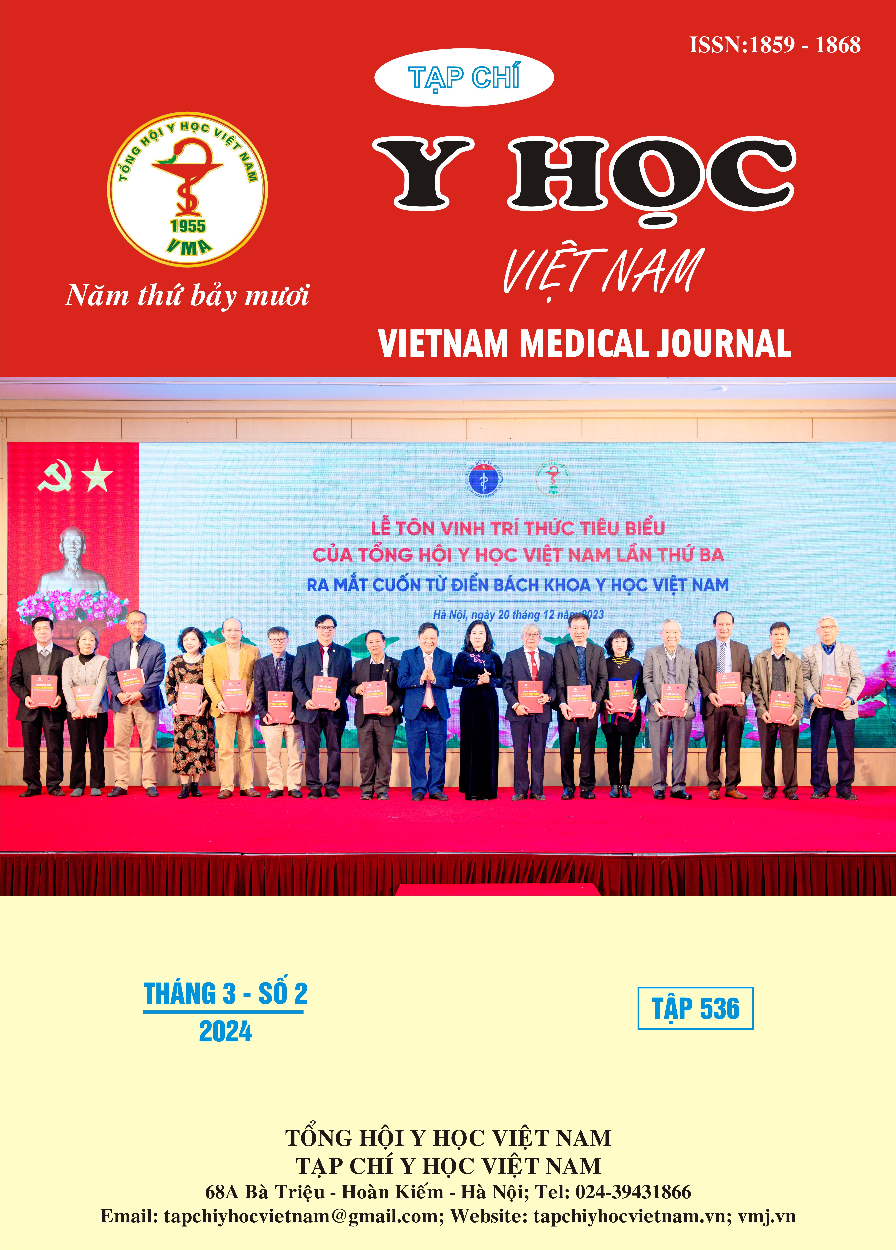ĐÁNH GIÁ KẾT QUẢ ĐIỀU TRỊ TĂNG SINH LÀNH TÍNH TUYẾN TIỀN LIỆT BẰNG PHẪU THUẬT NỘI SOI CẮT ĐỐT LƯỠNG CỰC QUA ĐƯỜNG NIỆU ĐẠO
Nội dung chính của bài viết
Tóm tắt
Mục đích của nghiên cứu: Đánh giá kết quả phẫu thuật nội soi cắt đốt lưỡng cực điều trị tăng sinh lành tính tuyến tiền liệt qua đường niệu đạo tại Bệnh viện Trung Ương Quân đội 108 từ 10/2021- 8/2023. Kết quả nghiên cứu: Tuổi trung bình nhóm bệnh nhân nghiên cứu là 69,99 ± 7,94, nhóm tuổi 60 - 69 là cao nhất (44,1%); Lượng dịch rửa trong PT: 25,26 ± 7,75 lít, tai biến trong PT là 1,5% (1 trường hợp thủng bao xơ); Không có trường hợp nào có biểu hiện hội chứng nội soi, thời gian rút thông niệu đạo phần lớn ≤ 3 ngày (61,8%), trung bình 3,46 ± 0,80 ngày; Ngày điều trị hậu phẫu trung bình là 5,00 ± 1,57 ngày, ít nhất là 3 ngày và nhiều nhất là 14 ngày; Tỷ lệ biến chứng sau mổ là chảy máu (2,9%), nhiễm khuẩn tiết niệu (2,9%), bí tiểu cấp sau rút thông (7,4%), tắc thông niệu đạo (4,4%), hẹp niệu đạo màng (1,5%), tiểu không kiểm soát (2,9%);Tại các mốc thời gian sau PT 1 tháng, 3 tháng và 6 tháng, các chỉ số IPSS, QoL, Qmax và PVR đều cải thiện so với trước mổ, sự khác biệt có ý nghĩa thống kê. Tỷ lệ thành công của B-TUVP là 100%, 2 BN có kết quả ở mức trung bình chiếm 2,9%;
Chi tiết bài viết
Tài liệu tham khảo
2. Botto H, Lebret T, Barré P, Orsoni JL, Hervé JM, Lugagne PM. Electrovaporization of the prostate with the Gyrus device. J Endourol. 2001;15(3):313-316. doi:10.1089/089277901750161917
3. Parsons JK, Dahm P, Köhler TS, Lerner LB, Wilt TJ. Surgical Management of Lower Urinary Tract Symptoms Attributed to Benign Prostatic Hyperplasia: AUA Guideline Amendment 2020. J Urol. 2020;204(4): 799-804. doi: 10.1097/ JU.0000000000001298
4. Brierly RD, Mostafid AH, Kontothanassis D, Thomas PJ, Fletcher MS, Harrison NW. Is transurethral resection of the prostate safe and effective in the over 80-year-old? Ann R Coll Surg Engl. 2001;83(1):50-53
5. Đỗ Thị Khánh Hỷ, Nghiên cứu một số đặc điểm dịch tễ học của u tuyến tiền liệt và đánh giá vai trò của PSA huyết thanh trong chẩn đoán và tiên lượng bệnh, Luận án Tiến sĩ Y học, Trường Đại học Y Hà Nội. 2004.
6. Cao Xuân Thành, “Đánh giá kết quả điều trị phẫu thuật u phì đại lành tính tuyến tiền liệt tại bệnh viện Trung ương Huế”.Y học Thành phố Hồ Chí Minh, 16 (3), Tr. 278-282. 2012.
7. Hoàng Văn Công, “Kết quả phẫu thuật nội soi cắt đốt tăng sinh lành tính tuyến tiền liệt tại Bệnh viện Trung ương Thái Nguyên”, Tạp chí Y dược Đại học Thái Nguyên, 226(05), tr. 24–28. 2021.
8. Riedinger CB, Fantus RJ, Matulewicz RS, Werntz RP, Rodriguez JF, Smith ND. The impact of surgical duration on complications after transurethral resection of the prostate: an analysis of NSQIP data. Prostate Cancer Prostatic Dis. 2019;22(2):303-308. doi:10.1038/s41391-018-0104-3
9. Nguyễn Thanh Tùng, “Đánh giá kết quả điều trị tăng sinh lành tính tuyến tiền liệt bằng phương pháp cắt đốt nội soi tại Bệnh viện Đa khoa tỉnh Bắc Ninh”, Luận văn Bác sĩ chuyên khoa cấp II. 2015.
10. Nguyễn Trường An, “Đánh giá kết quả phẫu thuật cắt u lành tính tuyến tiền liệt bằng nội soi qua niệu đạo”.Y học TP.Hồ Chí Minh, 12 (4), Tr. 187 - 192. 2008.


